There’s a worldwide shortage of corneas available for transplant, but a new 3D printing technique could help restore eyesight to millions.
It seems like 3D printing is making inroads into every industry, from shoes and clothing to rockets. Now, tissue engineers are building on the technology to ‘manufacture’ transplant-ready corneas.
The cornea, which is the outermost layer of the front of the eye, plays an important role in transmitting and refracting light. But damage from disease or injury can cause severe vision impairment or even blindness.
So far the only treatment is a cornea transplant, but demand far exceeds supply. The shortage has been compounded by the rising popularity of laser eye surgery because the tissue can’t be donated after the procedure.
This unmet need for corneas has inspired a team from Newcastle University in the UK to bioengineer a world-first artificial cornea using 3D printing technology.
Creating curved tissue
Although flat tissues have been created in the past, according to professor of tissue engineering Che Connon, who led the research, this is the first time shaped corneas have been produced using 3D printing.
The cornea is built using a ‘bio-ink’ comprising stem cells from a healthy donor cornea, alginate gel and collagen. This solution is then extruded into concentric circles to form an artificial cornea, and the stem cells grow around this scaffolding.
“Our unique bio-gel keeps the stem cells alive while producing a material that is stiff enough to hold its shape, but soft enough to squeeze out the nozzle of a 3D printer,” Connon said.
Although the technique, which is outlined in the journal Experimental Eye Research, still requires a healthy donor cornea, using stem cells allows one cornea to spawn many printed ones.
Each cornea can be custom made using a scan of the patient’s eye to determine the right size and shape. What’s more, they were able to 3D print a cornea in under six minutes.
These corneas aren’t ready for human eyeballs yet, though. First, they need to undergo further trials and animal studies to make sure the material is functional and fit-for-purpose. Connon said he also wants to fine-tune the 3D-printing process, but hopes the corneas could be in use within the next five years.
Interest in bioprinting
As availability of 3D printing technology goes up and costs come down, more engineers and scientists are experimenting with printing living tissues instead of plastics or metals. Most of this research is focused on using stem cells to rebuild or replace damaged tissues.
Products range from 3D-printed ’tissue papers’ to living tattoos that act as wearable health tests. Here in Australia, researchers at the University of Wollongong are busy perfecting a handheld 3D printer that uses stems cells and polymers to help bones and joints heal.
3D bioprinting is still an emerging technology, and it will be a few years before any of these techniques become standard procedure. However, Connon’s research is a good proof-of-concept and could spur more interest in bioprinting as potential solution to organ and tissue shortages.
